SB Television
Tips and Tackle for Catching Trophy Striped Bass in Western Long Island Sound
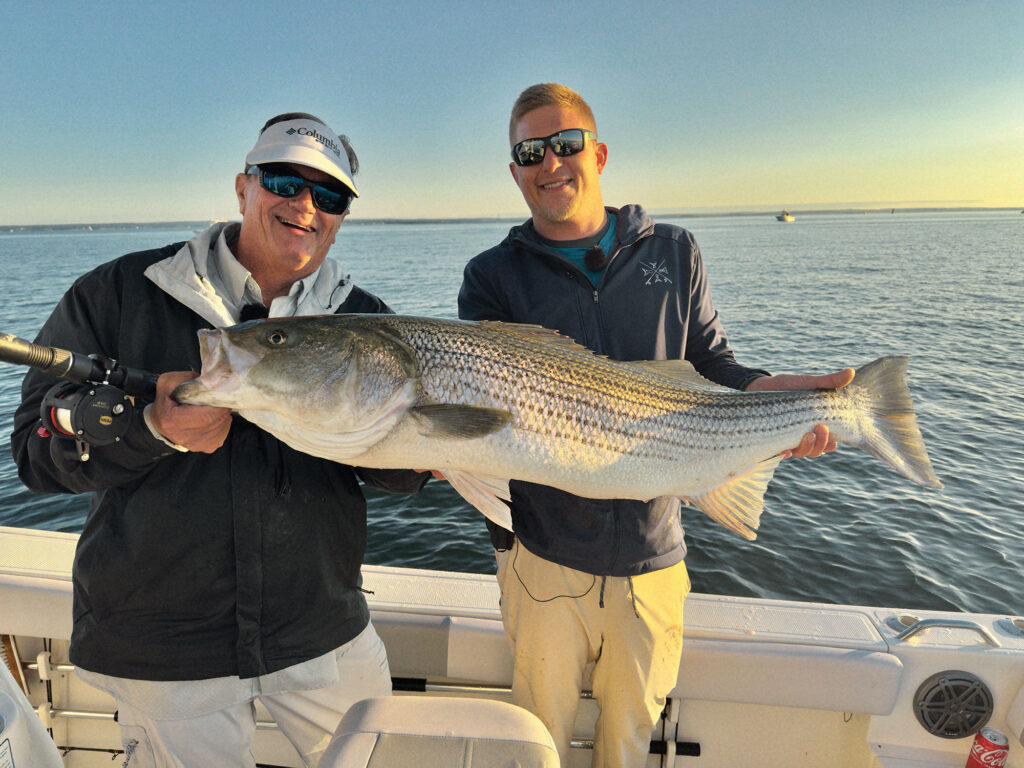 The “good old days” are now. Connecticut waters produce hefty stripers for anglers at first light.
George Poveromo
The “good old days” are now. Connecticut waters produce hefty stripers for anglers at first light.
George Poveromo
“A 50-pounder is the new 40-pounder,” quipped Rick Mola. “Trophy bass fishing in Western Long Island Sound has been exceptional over the past 10 years, and nothing short of incredible during the last few years.” As the owner of Fisherman’s World in Norwalk, Connecticut, few people know the Western Sound’s fisheries as thoroughly as Mola.
I’ve fished the Western Sound numerous times over the years, primarily out of Norwalk and Long Island’s Port Jefferson. Last year, Mola convinced me to trailer my Mako 214 north in June to showcase just how good this fishery has become. He said we’d likely catch striped bass in the 30- and 40-pound class, with a decent shot at a 50-pounder. In 2021, Mola released a fish over 60 pounds. Even better, he landed one over 70 pounds in 2022. Let’s not forget that the all-tackle 81-pound, 14-ounce world-record striped bass was landed off Westbrook in 2011.
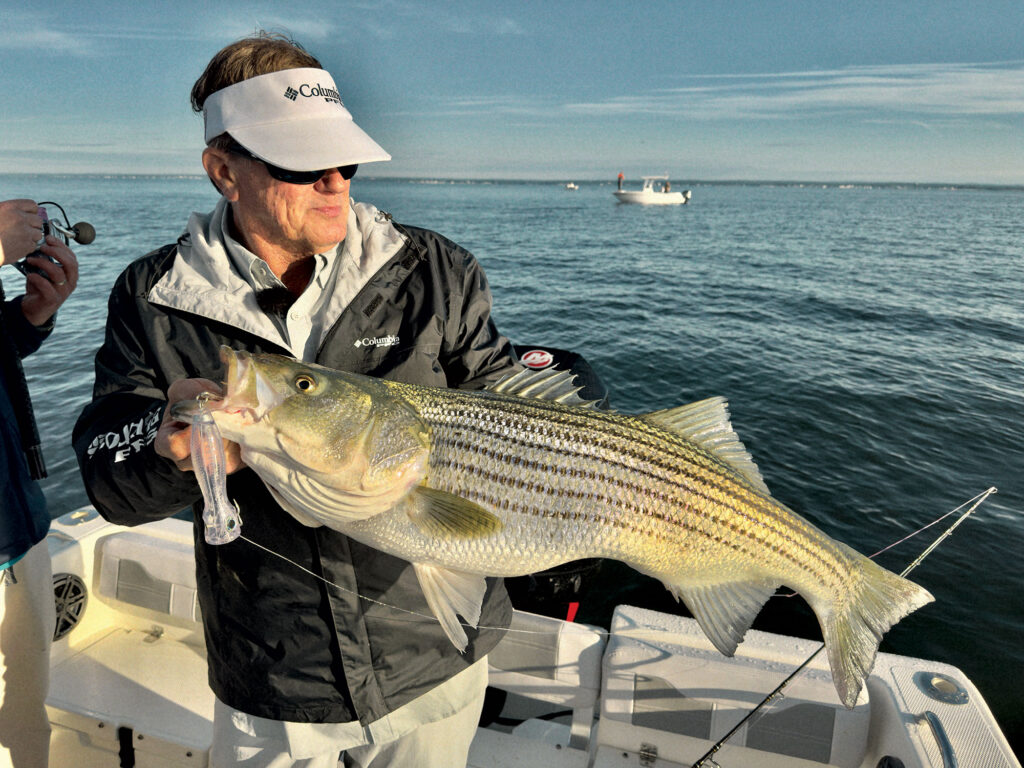 Topwaters catch bass near nervous bunker schools.
George Poveromo
Blitzed in the Morning
Topwaters catch bass near nervous bunker schools.
George Poveromo
Blitzed in the Morning
The opportunity to catch trophy bass on topwater plugs was the deal-clincher for me. Well that, and having “Mighty” Max Finch lead the way. Finch is a hardcore striper fanatic who pretty much lives on Western Long Island Sound when he’s not busy with his day jobs—one of which is working at Fisherman’s World. While chunking remains a deadly tactic, Finch said we’d target them with topwaters, flutter-style jigs and old-fashioned live-baiting.
Finch had us leave Norwalk Cove Marina in the dark, headed to a spot where he insisted on being prior to first light. “When the sun starts coming up, start looking for bunker schools,” Finch instructed. “Then we’ll race to them and pitch topwater plugs. The striped bass will be blitzing.”
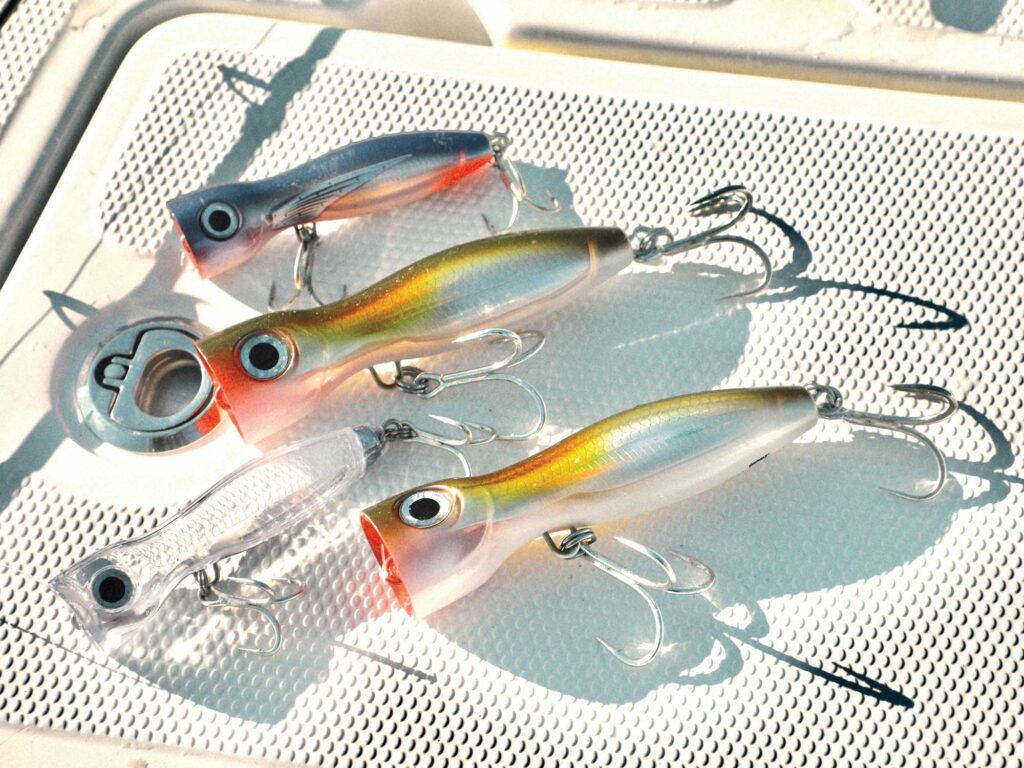 A clear popper sometimes out-produces the rest.
George Poveromo
A clear popper sometimes out-produces the rest.
George Poveromo
The plan was to cast chuggers into and along the edges of bunker schools. At our first bait pod, and after a few unanswered casts, I was about to pull my Rapala from the water when a bass clobbered it. And what a hole in the water it left! We soon released a 30-pound-class trophy. Finch missed a few strikes before scoring his first one. I had the rhythm and luck down quickly, scoring several more trophies on chuggers.
The tackle was simple: 40-pound fluorocarbon leaders and Penn Battle III 5000 spinning reels with 30-pound braid. Interestingly, my clear-colored lures far out-produced the hues Finch was pitching. Plug color was the only difference; we had identical tackle setups. Matching lure color with the most abundant bait is usually a sound decision. However, why did my clear lure out-produce ones with bunkerlike hues or blue-and-silver patterns? In my opinion, the clear lure picked up not only the color of the water but also the flashing silvers of bunker as it chugged through the schools. Did all this transmit more vibrancy and realism? On this trip, there was definitely something to it.
Popping and Jigging Tackle for Stripers Flutter GamesAs the bunker schools and topwater action dissipated, Finch went back on the hunt. He slowly motored about while locating—with help from sonar—groupings of striped bass holding along bottom hills and drop-offs. Then we’d drop jigs and convert those marks into more catches of big bass.
Both Mola and Finch told me about a hot jigging tactic that absolutely crushes trophy striped bass when they’re gorging on bunker. It’s known as the “flutter spoon.” Think of it like a flasher or muskylike spoon, modified with a heavy-duty split ring and swivel on the top end, and a heavy-duty split ring, swivel, and a single or treble hook on its opposite end. The origins stem from freshwater lake fishing for striped bass and the Ben Parker Magnum Spoon.
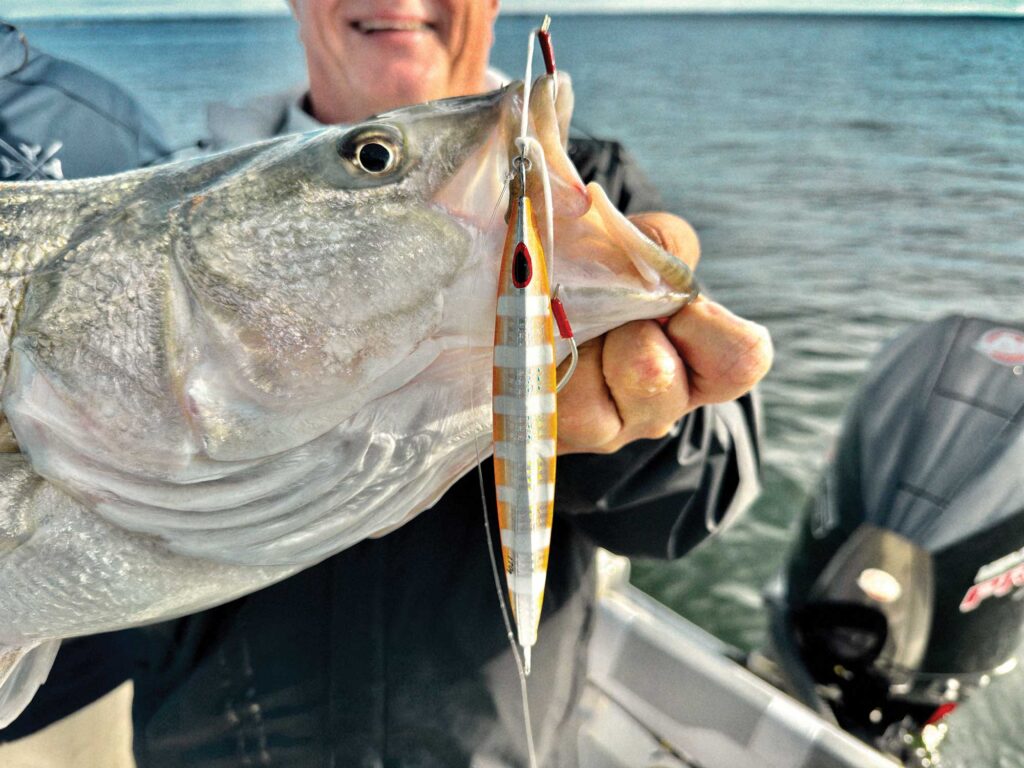 Metal jigs catch plenty.
George Poveromo
Metal jigs catch plenty.
George Poveromo
This large, wide and thin flasher mimics a large bunker, the size these bass were feeding on. It basically matches the hatch. Mola explained that it’s critical to work the flutter spoon straight up and down, with no line scope.
“Let it hit bottom, then repeatedly and rapidly lift the rod high overhead and immediately drop the rod tip to the water,” Mola advised. “The flutter spoon will resemble an injured bunker flailing about near bottom. Keep to that routine until the line begins scoping out, then reel up and drop again.”
Mola explained that the flutter spoon performs best when bunker is abundant. “When the bass are eating small baits, traditional diamond and flutter jigs produce best. However, when the bass are on big bunker, the flutter spoon will get most of the strikes.”
Mola recalled a time when he and two friends were chunking and live-lining on a hump. “It was slack tide, and the sonar was lit up like a Christmas tree with bass,” Mola said. “Two of us were fishing with bunker while our other friend dropped a flutter spoon between us. He caught seven or eight bass on it! I caught one bass on a bunker, and my other friend caught none.”
Back on my boat, Finch scored three bass with his flutter spoon. I scored one on a Williamson Kensaki Jig with bronze and orange highlights. Again, bunker was abundant, giving the advantage to the flutter spoon.
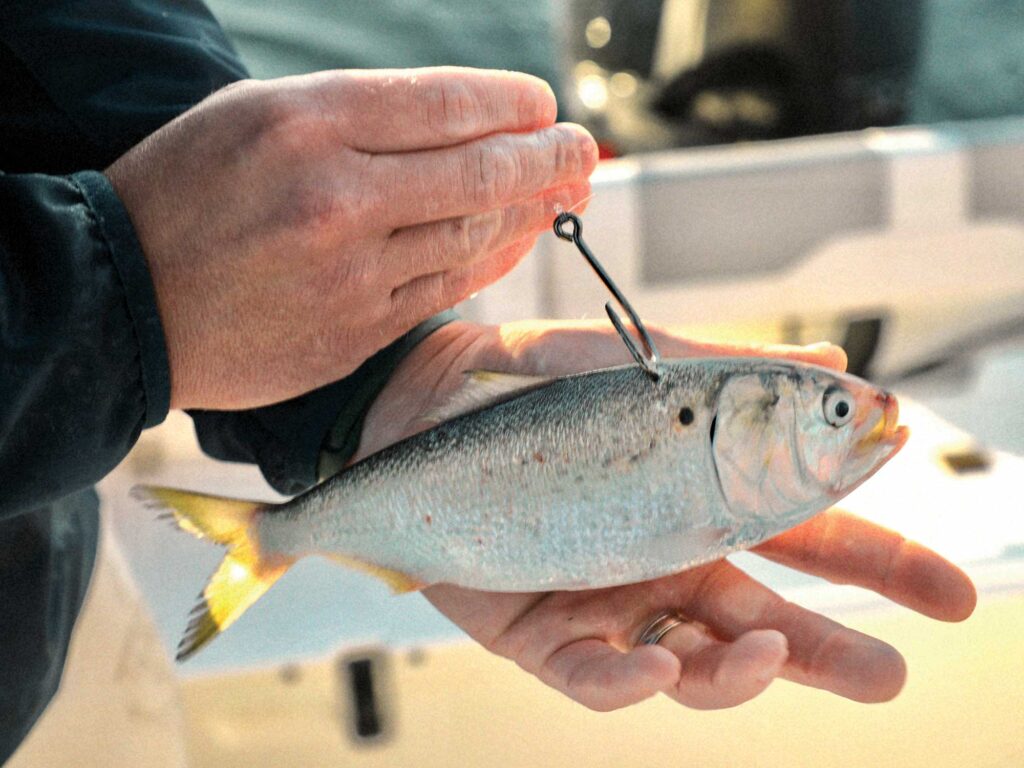 Tried-and-true bunker.
George Poveromo
Live-Lining is Legit
Tried-and-true bunker.
George Poveromo
Live-Lining is Legit
The next morning, we proceeded to catch more bass on topwaters—with the clear body once again out-producing the hued plugs. We caught a couple more bass by jigging, prior to shifting to live-lining bunker, which Finch netted earlier that morning.
One live bunker was free-lined behind the boat, with the other weighted and lowered near bottom. We used Penn Fathom 25 lever-drag reels (5.3-to-1 retrieve) spooled with 40-pound clear monofilament, 50-pound fluorocarbon leader and a 12/0 circle hook. To keep the hook out in front of the bait, Finch used a bridle.
As expected, the outgoing tide kept producing big bass—the largest from our live-lining efforts pushed 40 pounds. Circle hooks, mandatory when using live and dead natural baits for striped bass, prevent deep-hooking them. The heavier mono lessens fight time and bass succumbing to exhaustion.
Live-Lining Tackle for Striped Bass New England ResurgenceMola credits the numbers of large striped bass to the moratorium in Maryland and Chesapeake Bay from 1985 to 1989, as well as getting the commercial bunker boats out of Long Island Sound. The stocks of striped bass migrating through Long Island Sound, incidentally, are primarily Hudson River fish, where they winter.
“In the ’90s, I received a call from a customer who was near Green’s Light, which had acres of bunker,” Mola said. “He was witnessing a bunker boat wiping them out. The abbreviated story is that I contacted the Connecticut DEP about this and, shockingly, they asked: ‘What’s a bunker boat?’
 South Norwalk (SoNo) is a charming area dotted with coffee shops, taverns, restaurants and assorted stores along its walk. Norwalk’s public boat ramp, where we launched, is right down the street from the Residence Inn Norwalk, where we stayed. From the ramp, it was a quick boat ride to Norwalk Cove Marina. That’s a prime spot to keep your boat docked if you’re fishing for a couple of days. Rick Mola’s Fisherman’s World tackle center is close by too, just a short distance from the public boat ramp.
George Poveromo
South Norwalk (SoNo) is a charming area dotted with coffee shops, taverns, restaurants and assorted stores along its walk. Norwalk’s public boat ramp, where we launched, is right down the street from the Residence Inn Norwalk, where we stayed. From the ramp, it was a quick boat ride to Norwalk Cove Marina. That’s a prime spot to keep your boat docked if you’re fishing for a couple of days. Rick Mola’s Fisherman’s World tackle center is close by too, just a short distance from the public boat ramp.
George Poveromo
“A Connecticut bill was ultimately introduced and passed, banning commercial bunker boats from Long Island Sound,” Mola explained. “It was a very hotly contested bill. The moratorium and outlawing commercial bunker boats in Long Island Sound were two huge victories for our striped bass.”
Fishing the prime outgoing tide had us out on the water in the early dark and back at Norwalk Cove Marina by midmorning—perfect timing to load up my truck and stop by an old-fashioned seafood shack for lunch. Here, we enjoyed lobster rolls and fried clams. We were back in our rooms at South Norwalk’s Residence Inn by 2 p.m. One could certainly get used to such hours.
Read Next: Best Striper Topwater Lures of 2025
 George Poveromo (right) with Long Island Sound legend Rick Mola.
George Poveromo
George Poveromo (right) with Long Island Sound legend Rick Mola.
George Poveromo
Our trip was everything Mola promised it would be, and Finch knew where and how to get the job done. The weather was spectacular—lows in the 50s and highs barely breaking 70 degrees F, complete with bluebird skies and a breeze that varied between nonexistent and light.
If you’re yearning to challenge big striped bass on topwaters, fly, jigs or traditional natural baits, head to Norwalk this May or June. If that’s not incentive enough to float your boat, oversize bluefish are dependable side options—we caught plenty.
These days, fishing in the Sound off Norwalk is anything but dull. I can recall in years past when a 20-pound-class bass was considered big. Now it’s almost an embarrassment to catch one that size in waters flourishing with true heavyweights.
The post Tips and Tackle for Catching Trophy Striped Bass in Western Long Island Sound appeared first on Salt Water Sportsman.
- Home
- About Us
- Write For Us / Submit Content
- Advertising And Affiliates
- Feeds And Syndication
- Contact Us
- Login
- Privacy
All Rights Reserved. Copyright , Central Coast Communications, Inc.